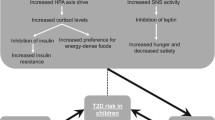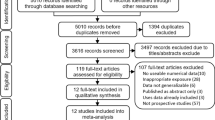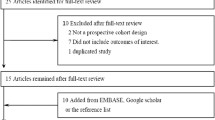Abstract
Purpose of Review
Many of the risk factors for heart disease have recently been shown to develop during childhood such as left ventricular hypertrophy and fibrous plaque lesions. As risk for cardiovascular disease in children and adolescents has risen, sleep duration has decreased, and inadequate sleep in children and adolescents has been found to be associated with cardiovascular disease risk. The aims of this manuscript are to provide an updated systematic review of the literature assessing sleep, hypertension, and cardiovascular risk and evaluate the strength of the evidence based on the available research.
Recent Findings
A systematic review was conducted using six databases from January 1, 2015 through March 9, 2018. We sought studies which looked at the relationship between sleep duration, sleep timing, or sleep quality and outcome variables of hypertension, inflammation, obesity, glucose or insulin, and lipids in children and adolescents. We found 24 studies which met our criteria. Nine studies included hypertension as an outcome variable; fifteen included obesity; thirteen included glucose or insulin; eight included lipids; and three included measures of inflammation.
Summary
The existing literature on sleep and cardiovascular disease in children and adolescents is limited and relatively weak. Only one RCT was identified, and the overwhelming majority of studies had a high risk of bias. The strongest evidence of an association with sleep is with obesity, hypertension, and insulin sensitivity. Further research using more standardized methods and objective measures is needed to determine if a causal relationship truly exists between sleep and cardiovascular risk.

Similar content being viewed by others
References
Papers of particular interest, published recently, have been highlighted as: • Of importance •• Of major importance
Benjamin EJ, Blaha MJ, Chiuve SE, Cushman M, Das SR, Deo R, et al. Heart disease and stroke statistics—2017 update: a report from the American Heart Association. Circulation. 2017;135(10):e146–603.
Berenson GS, Srinivasan SR, Bao W, Newman WP, Tracy RE, Wattigney WA. Association between multiple cardiovascular risk factors and atherosclerosis in children and young adults. N Engl J Med. 1998;338(23):1650–6.
Din-Dzietham R, Liu Y, Bielo M-V, Shamsa F. High blood pressure trends in children and adolescents in National Surveys, 1963 to 2002. Circulation. 2007;116(13):1488–96.
Ostchega Y, Carroll M, Prineas RJ, McDowell MA, et al. Trends of elevated blood pressure among children and adolescents: data from the National Health and nutrition examination survey 1988–2006. Am J Hypertens. 2009;22(1):59–67.
Sinaiko AR, Donahue RP, Jacobs DR, Prineas RJ. Relation of weight and rate of increase in weight during childhood and adolescence to body size, blood pressure, fasting insulin, and lipids in young adults. Circulation. 1999;99(11):1471–6.
Statistics NCfH. Health, United States. With special features on socioeconomic status and health. Hyattsville: U.S. Department of Health and Human Services; 2011. p. 2012.
Freedman DS, Mei Z, Srinivasan SR, Berenson GS, Dietz WH. Cardiovascular risk factors and excess adiposity among overweight children and adolescents: the Bogalusa Heart Study. J Pediatr. 2007;150(1):12–7.e2.
Kaufman FR. Type 2 diabetes in children and youth. Endocrinol Metab Clin N Am. 2005;34(3):659–76. ix-x
Matricciani LA, Olds TS, Blunden S, Rigney G, Williams MT. Never enough sleep: a brief history of sleep recommendations for children. Pediatrics. 2012;129(3):548–56.
Taheri S. The link between short sleep duration and obesity: we should recommend more sleep to prevent obesity. Arch Dis Child. 2006;91(11):881–4.
Capers PL, Fobian AD, Kaiser KA, Borah R, Allison B, Systemic Review DA. Meta-analysis of randomized controlled trials of the impact of sleep duration on adiposity and components of energy balance. Obes Rev. 2015;16(9):771–82.
Chen X, Beydoun MA, Wang Y. Is sleep duration associated with childhood obesity? A systematic review and meta-analysis. Obesity. 2008;16(2):265–74.
Spiegel K, Tasali E, Leproult R, Van Cauter E. Effects of poor and short sleep on glucose metabolism and obesity risk. Nat Rev Endocrinol. 2009;5(5):253–61.
Flint J, Kothare SV, Zihlif M, Suarez E, Adams R, Legido A, et al. Association between inadequate sleep and insulin resistance in obese children. J Pediatr. 2007;150(4):364–9.
Miller MA, Cappuccio FP. Inflammation, sleep, obesity and cardiovascular disease. Curr Vasc Pharmacol. 2007;5(2):93–102.
•• Matthews KA, Pantesco EJ. Sleep characteristics and cardiovascular risk in children and adolescents: an enumerative review. Sleep Med. 2016;18:36–49. This review examines the relationship between sleep and multiple factors of cardiovascular risk, and highlights the need for stronger research in this area.
Viswanathan M, Berkman ND, Dryden DM, et al. Assessing Risk of Bias and Confounding in Observational Studies of Interventions or Exposures: Further Development of the RTI Item Bank [Internet]. Rockville: Agency for Healthcare Research and Quality (US); 2013. Available from: https://www.ncbi.nlm.nih.gov/books/NBK154461/
•• Shaw ND, McHill AW, Schiavon M, Kangarloo T, et al. Effect of Slow Wave Sleep Disruption on Metabolic Parameters in Adolescents. Sleep. 2016;39(8):1591–9. This is the only RCT found in the last 3 years, and one of only a handful in the last several years; the results found no relationship between slow wave sleep disruption and glucose, insulin or C-peptide levels.
Anujuo KO, Vrijkotte TG, Stronks K, Jean-Louis G, Agyemang CO. Ethnic differences in sleep duration at 5 years, and its relationship with overweight and blood pressure. Eur J Pub Health. 2016;26(6):1001–6.
Carson V, Tremblay M, Chaput J, Chastin S. Associations between sleep duration, sedentary time, physical activity, and health indicators among Canadian children and youth using compositional analyses. Appl Physiol Nutr Metab. 2016;41:S294–302.
De Bernardi Rodrigues AM, da Silva Cde C, Vasques AC, Camilo DF, Barreiro F, Cassani RS, et al. Association of Sleep Deprivation with Reduction in insulin sensitivity as assessed by the hyperglycemic clamp technique in adolescents. JAMA Pediatr. 2016;170(5):487–94.
• Derks IPM, Kocevska D, Jaddoe VWV, Franco OH, Wake M, Tiemeier H, et al. Longitudinal Associations of Sleep Duration in Infancy and Early Childhood with Body Composition and Cardiometabolic Health at the Age of 6 Years: The Generation R Study. Child Obes. 2017;13(5):400–8. This is one of a few recent longitudinal studies examining sleep and cardiometabolic health; the results found no clear evidence for a relationship between sleep duration in early life and childhood cardiometabolic health.
Gonzaga NC, Sena ASS, Coura AS, Dantas FG, Oliveira RC, Medeiros CCM. Sleep quality and metabolic syndrome in overweight or obese children and adolescents. Rev Nutr. 2016;29(3):377–89.
Morita N, Kambayashi I, Okuda T, Oda S, Takada S, Nakajima T, et al. Inverse relationship between sleep duration and cardio-ankle vascular index in children. J Atheroscler Thromb. 2017;24(8):819–26.
Navarro-Solera M, Carrasco-Luna J, Pin-Arboledas G, Gonzalez-Carrascosa R, Soriano JM, Codoner-Franch P. Short sleep duration is related to emerging cardiovascular risk factors in obese children. J Pediatr Gastroenterol Nutr. 2015;61(5):571–6.
Paciencia I, Araujo J, Ramos E. Sleep duration and blood pressure: a longitudinal analysis from early to late adolescence. J Sleep Res. 2016;25(6):702–8.
Peach H, Gaultney JF, Reeve CL. Sleep characteristics, body mass index, and risk for hypertension in young adolescents. J Youth Adolesc. 2015;44(2):271–84.
Tavasoli A, Saeidi M, Hooman N. Correlation between sleep quality and blood pressure changes in Iranian children. J Compr Ped. 2015;6(1):e24805.
Alqaderi H, Redline S, Tavares M, Goodson JM. Effect of late bedtime on salivary glucose and abdominal obesity in children. Sleep Biol Rhythms. 2017;15(3):227–33.
Deacon-Crouch M, Skinner I, Tucci J, Skinner T. Association between short sleep duration and body mass index in Australian indigenous children. J Paediatr Child Health. 2017;54(1):49-54.
Hayes JF, Balantekin KN, Altman M, Wilfley DE, Taylor CB, Williams J. Sleep patterns and quality are associated with severity of obesity and weight-related behaviors in adolescents with overweight and obesity. Child Obes. 2017;14(1):11-17.
Li L, Fu J, Yu XT, Li G, Xu L, Yin J, et al. Sleep duration and Cardiometabolic risk among Chinese school-aged children: do Adipokines play a mediating role? Sleep. 2017;40(5):zsx042
Plumptre L, Anderson LN, Chen Y, Carsley S, Narang I, Hamilton J, et al. Longitudinal analysis of sleep duration and Cardiometabolic risk in young children. Child Obes. 2017;13(4):291–9.
Rudnicka AR, Nightingale CM, Donin AS, Sattar N, Cook DG, Whincup PH, et al. Sleep duration and risk of type 2 diabetes. Pediatrics. 2017;140(3):1–10.
Sluggett L, Wagner SL, Hardy C, Harris RL. Associations between sleep duration and indicators of Cardiometabolic disease in Canadian children and adolescents: analyses of the 2007-2009 Canadian health measures survey. Child Obes. 2016;12(5):325–33.
Dorenbos E, Rijks JM, Adam TC, Westerterp-Plantenga MS, Vreugdenhil AC. Sleep efficiency as a determinant of insulin sensitivity in overweight and obese adolescents. Diabetes Obes Metab. 2015;17(Suppl 1):90–8.
Pacheco SR, Miranda AM, Coelho R, Monteiro AC, Braganca G, Loureiro HC. Overweight in youth and sleep quality: is there a link? Arch Endocrinol Metab. 2017;61(4):367–73.
Peplies J, Börnhorst C, Günther K, Fraterman A, Russo P, Veidebaum T, et al. Longitudinal associations of lifestyle factors and weight status with insulin resistance (HOMA-IR) in preadolescent children: the large prospective cohort study IDEFICS. Int J Behav Nutr Phys Act. 2016;13:1–12.
Sayin FK, Buyukinan M. Sleep duration and media time have a major impact on insulin resistance and metabolic risk factors in obese children and adolescents. Child Obes. 2016;12(4):272–8.
Zhu Y, Li AM, Au CT, Kong AP, Zhang J, Wong CK, et al. Association between sleep architecture and glucose tolerance in children and adolescents. J Diabetes. 2015;7(1):10–5.
Hall MH, Lee L, Matthews KA. Sleep duration during the school week is associated with C-reactive protein risk groups in healthy adolescents. Sleep Med. 2015;16(1):73–8.
Jakubowski KP, Hall MH, Marsland AL, Matthews KA. Is daytime napping associated with inflammation in adolescents? Health Psychol. 2016;35(12):1298–306.
Morris CJ, Yang JN, Scheer FAJL. The impact of the circadian timing system on cardiovascular and metabolic function. Prog Brain Res. 2012;199:337–58.
Acknowledgements
We would like to thank Carolyn Holmes and Geeta Malik with the Lister Hill Library at the University of Alabama at Birmingham for their assistance in developing the search strategy for this review.
Author information
Authors and Affiliations
Corresponding author
Ethics declarations
Conflict of Interest
The authors declare no conflicts of interest relevant to this manuscript.
Human and Animal Rights and Informed Consent
This article does not contain any studies with human or animal subjects performed by any of the authors.
Additional information
This article is part of the Topical Collection on Sleep and Hypertension
Rights and permissions
About this article
Cite this article
Fobian, A.D., Elliott, L. & Louie, T. A Systematic Review of Sleep, Hypertension, and Cardiovascular Risk in Children and Adolescents. Curr Hypertens Rep 20, 42 (2018). https://doi.org/10.1007/s11906-018-0841-7
Published:
DOI: https://doi.org/10.1007/s11906-018-0841-7




